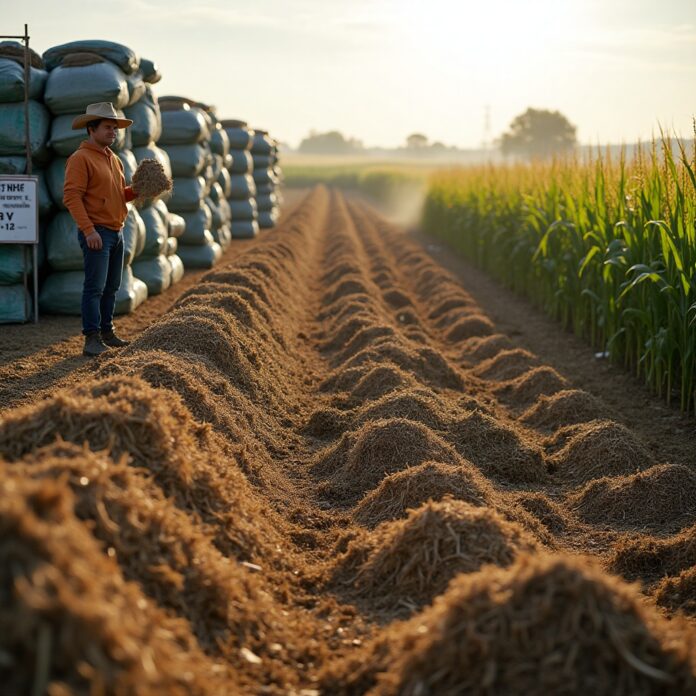Let’s talk about turning chicken waste from a headache into a goldmine. Imagine this: instead of worrying about piles of manure and the lingering smell, you could transform it into a product that crop farmers actively seek out. This isn’t just wishful thinking—it’s a reality grounded in science, economics, and good old-fashioned ingenuity. The organic fertilizer market is booming, driven by farmers who crave sustainable alternatives to synthetic chemicals. By converting poultry waste into fertilizer, you’re not only solving a disposal problem but tapping into a $12 billion global industry. Let’s dig into how you can do this efficiently, profitably, and without losing your sanity over odors or regulations.
Understanding Chicken Waste as a Resource
Chicken waste is like an unpolished gem. A typical batch of poultry litter contains roughly 3% nitrogen, 2% phosphorus, and 2% potassium (the holy trinity of plant nutrition), along with organic matter that feeds soil microbes. But here’s the catch: if mishandled, that same nutrient-rich waste can leach phosphorus into waterways, suffocate aquatic life, and release ammonia gas that stings your eyes and irritates your neighbors. The key is balance. Think of it as a recipe—too much of one ingredient (like nitrogen) and you’ll end up with environmental stew gone wrong. The goal? Process it right, and you’ve got a product that’s safe, stable, and ready to nourish crops.
Step-by-Step Process: Turning Waste into Fertilizer
Odor Control Strategies
Let’s tackle the elephant in the room: the smell. Odor isn’t just a nuisance—it’s a sign of inefficiency. Ammonia emissions mean you’re losing valuable nitrogen. Start by mixing manure with carbon-rich materials like straw or sawdust (aim for a 25:1 carbon-to-nitrogen ratio). This balances the decomposition process and tames the stench. Turn the pile weekly with a compost turner—think of it as fluffing a giant, earthy pillow to let it breathe. For stubborn odors, sprinkle microbial inoculants (like those used in bokashi composting) or add alum, a safe acidifier that locks in ammonia. If you’re feeling fancy, anaerobic digesters can trap odors while producing biogas—a two-for-one deal that powers your farm and keeps the air fresh.
Processing Methods
Now, let’s get your hands dirty. Composting is the bread and butter of waste conversion. Layer manure with carbon materials, build windrows, and monitor temperatures like a hawk. At 150°F, pathogens die, weed seeds combust, and you’re left with crumbly, earthy-smelling compost. Pelletizing takes it up a notch: dry the compost, run it through a granulator, and coat the pellets with anti-dust agents. The result? A product that’s easy to bag, ship, and spread. For liquid lovers, anaerobic digestion produces a nutrient-packed digestate that’s perfect for fertigation systems.
Packaging Solutions for Market Appeal
Your fertilizer could be a superstar, but no one will notice if it’s dressed in a potato sack. Opt for biodegradable bags or recycled plastic packaging—crop farmers love sustainability, and your branding should scream “eco-friendly.” Label clearly: list the NPK ratio, application rates, and certifications (like USDA Organic or OMRI listing). For bulk buyers, consider reusable totes or direct truckload delivery. Small-scale farmers? Offer 10-pound bags with a rustic, handcrafted vibe. Pro tip: Include a QR code linking to a video of your composting process. Transparency builds trust.
Selling Strategies to Crop Farmers
Targeting the Right Buyers
Not all farmers shop the same. Leafy green growers will salivate over high-nitrogen blends, while corn farmers want slow-release phosphorus. Host a field day to showcase your product’s impact on soil health—demonstrate how it boosts water retention or balances pH.
Building Trust
Farmers are skeptics by nature. Win them over with third-party lab tests proving your fertilizer’s nutrient content and safety (no heavy metals, please). Share testimonials: “After switching to pelletized poultry compost, my soybean yields jumped 15%.” Better yet, partner with local agronomists to endorse your product.
Distribution Channels
Skip the middleman. Sell directly through farm co-ops or online marketplaces like FarmDrop. If tech isn’t your thing, old-school flyers at feed stores work wonders.
Regulatory and Economic Considerations
Compliance
The EPA isn’t your enemy—they’re just picky about phosphorus runoff. Stick to application limits based on soil tests, and keep records like your farm’s future depends on them (it does). Permits for digesters? Yes. Fines for ignoring regulations? Also yes.
Cost-Benefit Analysis
A basic composting setup runs $10k–$20k. Pelletizing machines? Double that. But consider the math: Disposing of waste costs $30/ton. Selling fertilizer earns $50/ton. At 500 tons/year, you’re netting $10k annually. Break-even in 2–3 years, then pure profit.
Case Study: From Waste to Paycheck
Meet Jake, a Georgia broiler farmer drowning in litter. He invested $15k in a used pelletizer, partnered with a local hay farmer, and started selling 40-ton batches at $75/ton. Two years later, he’s saving $8k/year on disposal and earning $30k from sales. His secret? “Start small, prove the concept, then scale.”
Troubleshooting Common Challenges
- Odor creeping back? Add more sawdust or turn the pile daily for a week.
- Pellets crumbling? Adjust the moisture content before granulating.
- Buyers hesitant? Offer free soil tests with their first purchase.
You’re not just managing waste—you’re closing the loop in a system that rewards both your wallet and the planet. Start with a single compost pile. Master it. Then expand. The road from chicken coop to crop field is paved with challenges, but every step forward is a win for your farm and the earth. Ready to turn “waste” into “worth”? Grab a pitchfork and let’s get started.


